Different Fermentation pathway of bacteria
1. Alcoholic fermentation
- In this pathway first glucose is converted into Pyruvate by glycolysis. And then alcohol dehydrogenase reduces the pyruvate into ethanol and CO2.
- Metabolism of pyruvate to produce ethanol occurs in two steps.
- 1st step: pyruvate is first decarboxylated into Acetaldehyde and CO2. This reaction is catalyzed by the enzyme Pyruvate decarboxylase with Thymine pyrophosphate (TPP) as co-enzyme.
- 2nd step: Acetaldehyde is then reduced to ethanol by NADH2. This reaction is catalyzed by enzyme Alcohol dehydrogenase. NAD+ is regenerated in this step.

Net equation for alcoholic fermentation is
Glucose+ 2ADP +2Pi…………………. 2Ethanol +2CO2+2ATP
- Examples: Sacharomyces cereviseae, Pseudomonas
Application:
- Alcoholic fermentation is important in food and industrial microbiology and is used to produce beer, wine, distilled sprits etc.
- It is also used in production of fermented food products.
2. Lactic acid fermentation:
- In this pathway pyruvate is reduced to lactic acid. This is a single step reaction carried out by Lactic acid bacteria (LAB)
- There are two types of lactic acid fermentation.i. Homo lactic fermentationii. Hetero lactic fermentation
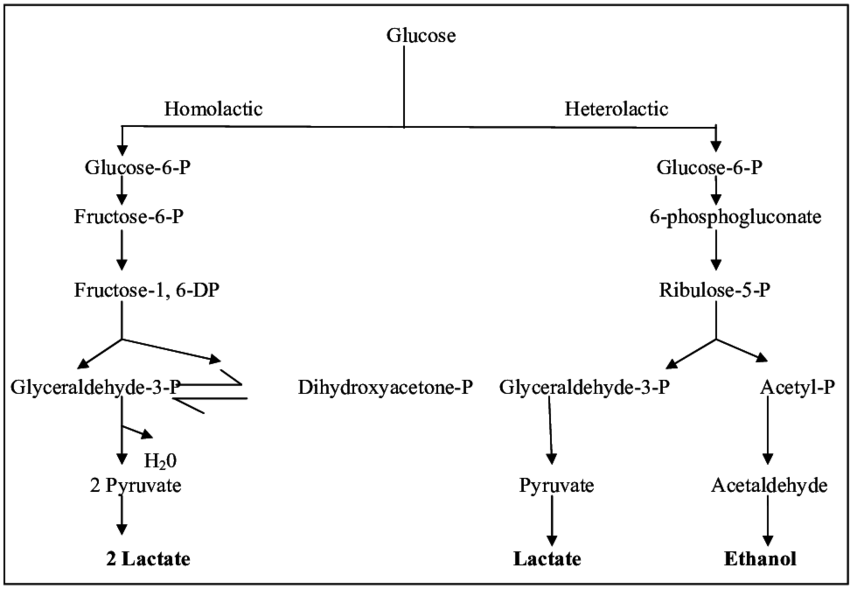
Homolactic fermentation:
- In homolactic fermentation, end product is lactic acid.
- Pyruvate is reduced to lactate or lactic acid by the enzyme lactate dehydrogenase (Pyruvate reductase).
- Homolactic bacteria: Streptococcus thermophiles, Streptococcus lactis, lactobacillus lactis, Lactobacillus bulgarius, Pediococcus, Enterococcus
Application:
- Homolactic fermentation is important in dairy industry for souring of milk to produce various fermented products
- Streptococcus mutant, a bacteria responsible for dental caries is a homolactic fermenting bacteria.
- Lactobacillus spp in the digestive tract of human helps in digestion of lactose present in milk.
- Lactobacillus spp are used as probiotic.
Heterolactic fermentation:
- In hetero lactic fermentation, end product is ethanol and CO2 in addition to lactic acid.
- In this reaction glucose is first metabolized to pyruvate, acetic acid and CO2 by Pentose phosphate pathway.
- Pyruvate is then reduced to lactic acid whereas acetic acid is reduced to ethanol and CO2.
- Heterolactic bacteria: Leuconostoc mesenteroides, Lactobacillus bifermentous, Leconostoc lactis
3. Mixed acid fermentation:
- In mixed acid fermentation, mixture of acids such as lactic acid, acetic acid, ethanol, formic acid etc are produced as the end product.
- At first pyruvate is cleaved by the enzyme Pyruvate formate lyase to yield formic acid and Acetyl coA.
- From formic acid various other end products such as acetic acid, lactic acid, succinic acid, ethanol or CO2 and water are formed according to types of pathway and types of bacteria. However formic acid is always the intermediate product in this pathway.
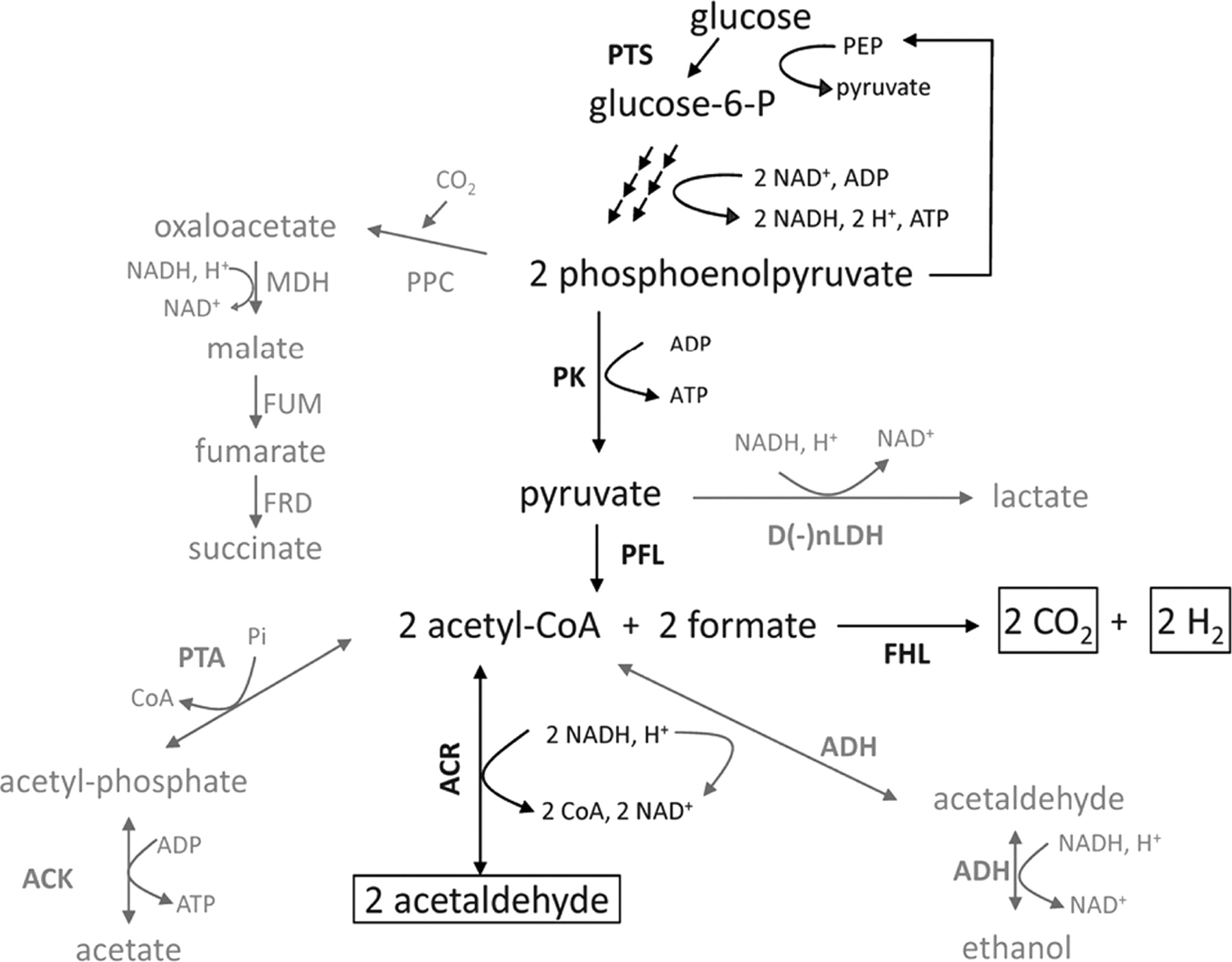
- This pathway is followed by member of Enterobacteriaceae family such as E. coli, Salmonella, Klebsiella etc.
- This fermentative pathway is the basis of Methyl red test.
4. 2,3-Butanediol fermentation:
- In this pathway 2,3-butanediol is the end product.
- Some Pyruvate produced during glycolysis is metabolized as in mixed acid fermentation but most of the pyruvate is condensed to form α-acetolactate.
- α-acetolactate undergoes decarboxylation in the presence of enzyme pyruvate decarboxylase to produce Acetoin (acetyl methylcarbainol) which is reduced by NADH2 to form 2,3-butanediol.
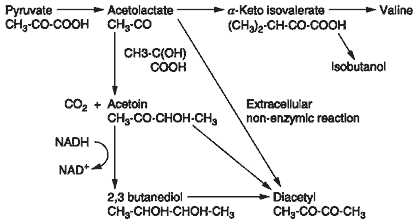
- This pathway is followed by some member of Enterobacteriaceae famil. Eg Klebsiella
- This fermentative pathway is the basis of VP test.
5. Butanol fermentation:
- In this pathway pyruvate is converted into butanol or butyrate. Other end product such as Acetone and CO2 or Isopropyl alcohol and CO2 may formed by this pathway.
- This pathway is present in Clostridium spp
- At first Clostridium spp convert pyruvate into AcetylcoA aerobically.
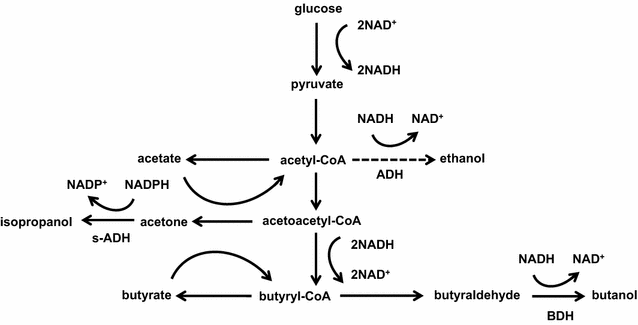
- Two molecule of acetylcoA condenses in the presence of enzyme acetyl-transferase to from AcetoacetylcoA.
- AcetoacetylCoA is reduced to β-hydroxybutyrylcoA by NADH2 in the presence of enzyme hydroxybutyrate dehydrogenase.
- β-hydroxybutyrylcoA is reduced by enoylcoA hydratase to form CrotonylcoA and water.
- CrotonylcoA is further reduced to butyrylcoA by an enzyme NAD-linked dehydrohenase.
- ButyrylcoA and acetate act together with fatty acid coA transferase to form acetylcoA and butyrate. Acetyl coA then recycle in the reaction.
6. Propionic acid fermentation:
- In this pathway propionic acid and CO2 is the end product.
- This pathway is carried out by Propionic acid bacteria (PAB).
- These bacteria ferment glucose or lactate to propionic acid under anaerobic condition.
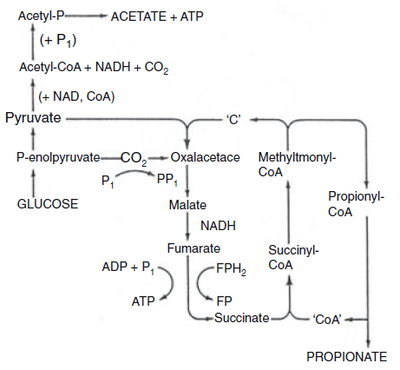
- Pyruvate reacts with methyl malonyl coA to form Propionyl coA and Oxaloacetate.
- Oxaloacetate give rise to malate, fumarate and succinate by reverse TCA cycle.
- Propionyl coA transfer its coA to succinate to form succinylcoA and propionate
- Example: Propioonibacterium










0 comments:
Post a Comment